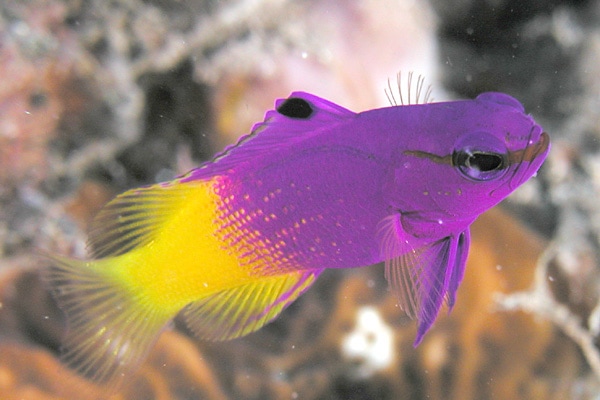
Are you a beginner or an experienced aquarist? It doesn’t matter because whatever your answer is, a Royal Gramma will be a great addition to your home aquarium. Not only do they add an exotic splash of color to the mix, but they are straightforward to care for. They don’t need much, just a couple of hiding places and reefs to play in. They are also reasonably priced, and as long as you keep the water conditions relatively stable, they can be your companions for 5 years or more.
So, if you want to add more aesthetic value to your water tank, nothing can suit you better than the Royal Grammas. Our article is the path carved for both the beginner and pro aquarist as we will throw limelight on the necessary things related to caringrelated caring for the Royal Grammas.
Table of Contents
Royal Gramma: A Quick Overview
Royal Grammas are small, colorful fish with a distinctive purple and yellow coloration. They are native to the Caribbean and prefer warm, clear water with plenty of hiding places. They are peaceful and can be kept with other peaceful fish.
Royal Gramma: The Care Guide
The Royal Gramma is recognized worldwide for its stunning beauty and peaceful nature. The color variation is admirable and eye-catching. So, this fish falls into the ‘add to the aquarium’ list for beginners and advanced level aquarists.
This shy saltwater fish bears the scientific name Gramma Loreto and are native to the Atlantic and Caribbean ocean. These species prefer deep water reefs, corals, caves, crevices to hide.
The Royal Gramma comes in 3 inches and can live 5 to 6 years or maybe more than that. The vibrant color of their body is the crucial factor for considering them to add to the aquarium.
The Royal Gramma species is not aggressive and can go along with the other groups or their own groups. Because of their color, they appear appealing to people and become their favorite pet to spend time with. However, you can easily buy them online or from the reputed fish sailing shops. Fortunately, they do not cost you much, and you can bring them home by spending $20 to 40 dollars for one Royal Gramma.
This article will educate you on their care level, appearance, water temperament, tank mates, tank landscape, diet, and other essential things. So, without further ado, let’s get started.
Royal Gramma Overview
We think it’s pretty hard to come across a fish that is more eye-catching and breathtaking than the Royal Gramma. The word royal is kind of contradicted by the word gramma, which sounds like a Grandma if sputtered, but that doesn’t take away from the beauty and elegance of this purple and yellow fish. They are also known as fairy basslet and Gramma Loreto.
Whatever you call them, they are small and vividly colored saltwater fish native to the Caribbean. They are quite peaceful fish and can survive quite well in a saltwater aquarium. Since they are naturally a hardy species, they are great additions to any aquarium for experts and are a great beginner fish to have for amateur aquarists.
Let’s quickly check out the facts related to the Royal Gramma in the chart mentioned below.
|
Information Chart |
Royal Gramma |
|
Scientific Name |
Gramma Loreto |
|
Common Name |
Royal Gramma, Fairy Basslet |
|
Family |
Grammidae |
|
Care Level |
easy |
|
Temperament |
peaceful |
|
Color |
Vibrant purple and yellow |
|
Size |
3 inches |
|
Lifespan |
5 to 6 years |
|
Diet |
Carnivore |
|
Minimum Tank size |
30 gallons |
|
Temperature |
72℉ to 80℉ |
|
pH Level |
8.1 to 8.4 |
|
Water Hardness |
8° to 12° dKH |
|
Water Conditions |
Saltwater |
|
Tank mate Compatibility |
Peaceful |
The Appearance Of Royal Gramma
As said before, one of the unique things about the Gramma Loreto or fairy basslet is its coloration. There are many aquarists who dream of an exotic and tropical-looking aquarium.
This fish has a black line that starts from the mouth and ends in the back part of its head. Also, they have a black spot in the dorsal fin.
Moreover, it is impossible to understand the difference between male and female Royal Gramma. They are mainly admired for the striking color combination that will lead every hobbyist or aquarist to add them to the water tank.
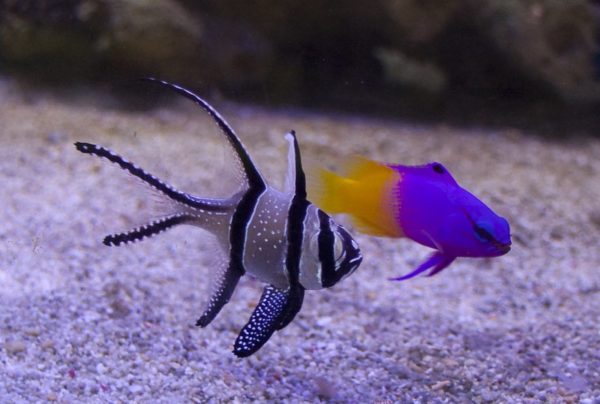
Origin And Family
The Royal Gramma is a small and colorful saltwater fish from the Grammidae family and is native to the tropical waters of the Caribbean. They can be seen in the western Atlantic regions as well. In addition to that, Gramma Loreto is found in Venezuela, Bermuda, Central America, the northern part of South America.
Royal Gramma Color
They are composed of opposite colors on the color wheel – purple and yellow. The two colors together get sewed through the band, where the two colors touch around its torso filled with tiny little dots.
If looked at closely, you will also notice these fishes have a thin black stripe that runs from the bottom of the mouth up past the middle of the eyes to the back. Males tend to be more brightly colored than females.
Royal Gramma: Male And Female Difference
The fascinating factor to note here is that you cannot identify male and female Royal Grammas in their initial stages because they are not born as males and females. They are all female at the time of birth.
However, some of them change sex after a particular time and become male. Additionally, after becoming male, they become aggressive and more significant than the female, and they have more variety of colors than the female Royal Grammas.
Lifespan Of Royal Gramma
How long does a Royal Gramma live? Many aquarists ask this question, and we also recommend that they know this vital aspect of the Royal Gramma.
Ideally, the typical lifespan of a Royal Gramma fish is between 5 to 6 years. Their lifespan closely depends on the care they are receiving. If taken care of better, they can last longer than 6 years.
The little fish can live quite long despite their size. You can expect them to be around for more than 5 years. Depending on the gramma care, these fish tend to live longer if the environment suits them.
Royal Gramma Size
The Gramma Loreto is a small fish that won’t take much space. They can grow up to only about 3 inches in captivity. This typical fish, Royal Gramma, can grow up to 3 inches on the lower end and 4 inches in the larger specimen. However, the sizes may vary in terms of various gender, groups, and genetics.
Royal Gramma Natural Habitat
The Royal Gramma fish is the most peaceful fish any aquarist can ever have. And this saltwater specimen mainly belongs to the Western Atlantic region. So, they enjoy water reefs, rocks, caves and stay within them.
This species is not fond of swimming, and they usually wait in their caves rocks and wait for the floated food. In addition to that, they only prefer dull light. Hence, if you want to have one pair of Royal Gramma or a group, you must recreate their natural habitat.
Royal Gramma Care Level
Although they are hardy like a goldfish, the Royal Gramma still requires a certain amount of care with elements you need to make sure are kept at optimal levels. Water conditions and the tank environment are critical components to keeping healthy and happy royal grammas.
Not only will their environment impact their lifespan and health, but their diet will as well, but more on that later. All in all, they are the perfect beginner fish for budding aquarists, and experts find that they do brighten up the tank without demanding much effort and care. Another fantastic thing about these vivid creatures is their natural immunity to many common fish diseases.
Royal Gramma Tank Set-up
Recreating their natural habitat in your water tank is necessary for their survival. These fish are suitable for a 30 gallons water tank, which is the minimum size.
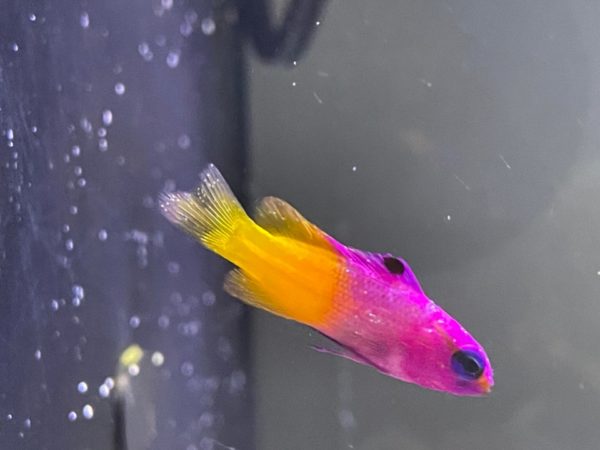
However, you can use 20 gallons as well when they are juveniles. But as they grow up, they need to keep in 30 or 40 gallons water tank size for one Royal Gramma. If you wish to keep a pair, then the 50 gallons water tank is the perfect one to serve the purpose.
As these fish do not enjoy swimming, they jump a lot, so it is necessary to have a tight-fit lid for the aquarium. Additionally, do not forget to add dull light and caves and rocks to hide and rest.
Tank Size And Specifications
The Royal Gramma prefers space, so if you have 30 gallons of the water tank, that will do good for them. They belong to the deepwater reefs, so adding crevices, rocks, and caves in the tank is required to hide.
Optimum Tank Size For Royal Gramma
The minimum tank size for the Royal Gramma is 30 gallons, and the optimum tank size is 50 gallons to keep a pair of the Royal Gramma.
Tank Shape For Royal Gramma
As for the size of the aquarium, we would suggest no less than 30 gallons. 30 gallons is the minimum for one Royal Gramma, and if you intend to keep more, you would need to add 20-30 gallons per fish. If you plan to have enough for them to shoal together, you are looking at a tank that exceeds 100 gallons. Even for such small fish, they do need a lot of space.
Substrate
As the Royal Gramma prefers deep water reefs, you need to add that in the water tank and as substrate in the tank’s floor, using sand can be a good choice.
How Many Royal Gramma In 30/40 Gallons Tank?
You can put one Royal Gramma in a 30 or 40 gallons water tank. However, if you want to have a pair of them, use 50 gallons of the water tank. Apart from that, the water tank must be 100+ gallons water tank size to keep them in a group.
Water Parameter For Royal Gramma
The Royal Gramma is a hardy saltwater specimen, so they prefer a specific water temperature. Moreover, the water tank must have to be above 30 gallons.
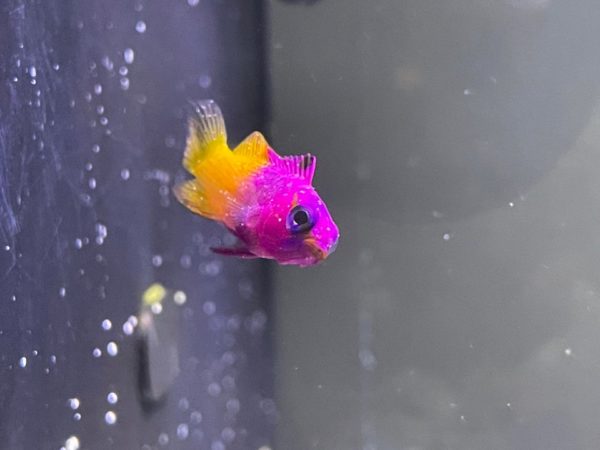
Water Temperature
Since they are native to the Caribbean, the ideal water temperature for Royal Gramma ranges from 72-80 degrees Fahrenheit (22-27 degrees Celsius) with a specific gravity of 1.020-1.025.
Water pH level And Hardness
PH levels will be slightly alkaline at 8.1-8.4 and water hardness at 8-12° dKH.
Royal Gramma Tank Landscape
As said, the Royal Gramma is a hardy fish that can do well with the right tank size and water conditions. They need a reef tank since their natural environment is thickly populated with reefs, coral, and overhanging. They love to hide, and they aren’t the best swimmers. For this reason, you should decorate your tank with plenty of aquarium plants and rocks, and little caves for them to hide in.
And you need to maintain the water parameters as well for their survival.
Maintenance and Care
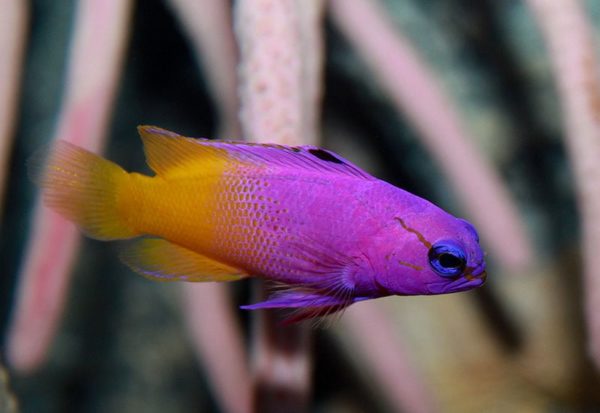
Don’t worry too much about your Royal Gramma as they are tough little creatures that don’t have the same disposition for common diseases. Not only that, but they can do wonders for the tank environment and other fish by feeding on dead organisms and cleaning up the tank.
Just make sure the water and tank conditions are right, and you will never really have to worry about the health of your Royal Gramma. Gramma care is easy once you know all the basics that they need.
Compatibility
Even though they can get along with just about anyone, most expert aquarists suggest keeping just one Royal Gramma in your aquarium. It can be tempting to fill it up with shades of yellow and purple, but it could lead to a duel over territory. We understand if you would like to keep at least 2 to breed with, and if that’s the case, then remember to offer them enough space.
Make sure you can have room for a 50-60-gallon aquarium and have enough substrate and decorations for each one to have its own space. Even if you do not intend to breed the royal gramma, we would still advise you to purchase one of each sex to minimize aggression.
Some people have successfully kept entire tanks full of Royal Gramma, but that takes a lot of work, a lot of space, and introducing them all together without a particular fish having established dominance first.
Diet For Royal Gramma
Since they are so small, Royal Grammas can only feed on types of plankton in the wild. You can expect a royal gramma diet to consist mainly of zooplankton and phytoplankton. Another fantastic ability that contributes to the awe of the royal gramma is they are known as cleaner fish. They clean other fish by feeding off of the parasites on their scales. It’s a symbiotic relationship that benefits both parties.
If there aren’t other fishes in the aquarium, their main diet should consist of Mysis Shrimp and Brine Shrimp since they are technically classified as carnivores. The royal gramma also cleans up any shed and floating crustaceans of the fish scales in the tank. They are a colorful addition to the tank and beneficial in maintaining the environment.
Keeping them on a steady diet of Mysis Shrimp and brine shrimp will keep the Royal Grammas happy and healthy for the most part. You can incorporate the easy-to-feed pellets and flakes from time to time since Royal Grammas are very easy to feed and will accept almost anything.
It’s best to keep rotating their diet and keeping them interested in a wide variety of foods. They are hardy little fish that can do well with any feeding schedule. Usually, the Royal Gramma should eat a few times a day. Even if they are in their hiding places and hidden from sight, you should still feed them as they will dart out from their spots and snatch up food quickly.
How Often Should You Feed Royal Gramma?
The Royal Gramma involves minimum care only, and you only need to feed them 2 to 4 times a day. However, this can vary from one Royal Gramma to another.
Royal Gramma Behavior And Temperament
Is royal gramma aggressive? Many people have the same question. Well, to answer this, they are not aggressive, and they are the most peaceful species you can ever have for your aquarium.
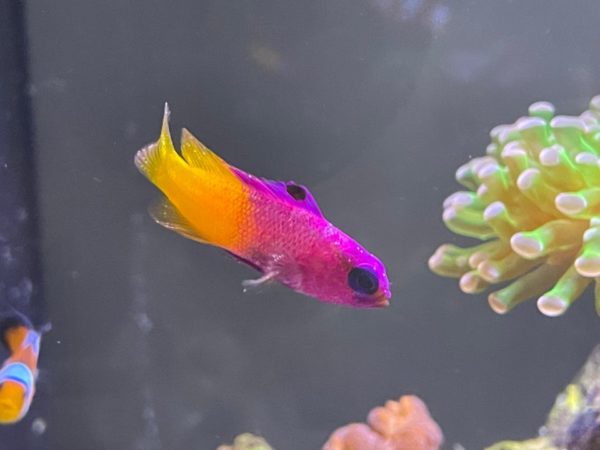
This fish is calming and shy by nature, and one will not have any issues regarding them. They can go along with the other pair or in the group. However, if they find another species is intruding in their home space, they get agitated and react.
They have issues with their rival Royal Dottyback, and we would recommend you not keep them in a water tank.
One thing the royal Gramma basslet is known for that is more on the opposing end of the spectrum is jumping. Despite their small size, they can jump so high that you should get ready to see your royal grammas out of the tank if you don’t have a lid on your aquarium.
As most people know or are taught, when you see a fish upside down in your tank, it can cause panic. You don’t know if your fish is sick or worse. However, if this happens with Royal Grammas and there are no other accompanying symptoms, it’s no cause for concern.
These bright little fish are known to hang out upside down or swim upside down under hard surfaces.
Are Royal Gramma Lone Or A Societal In Nature?
To answer, the Royal Gramma gets along with others very well, and they love to be with others. If one has enough water tank space, they can keep the grammas in a group to socialize. In short, it prefers company over being alone.
Royal Gramma Tank Mates
Royal Gramma are peaceful creatures that can live very well with other fish. If you have a saltwater tank, adding a Royal Gramma or two into the mix is as easy as 1,2,3. They do well with other peaceful and colorful fish species such as clownfish and more. However, we said that they tend to want to chase intruders who encroach on their space.
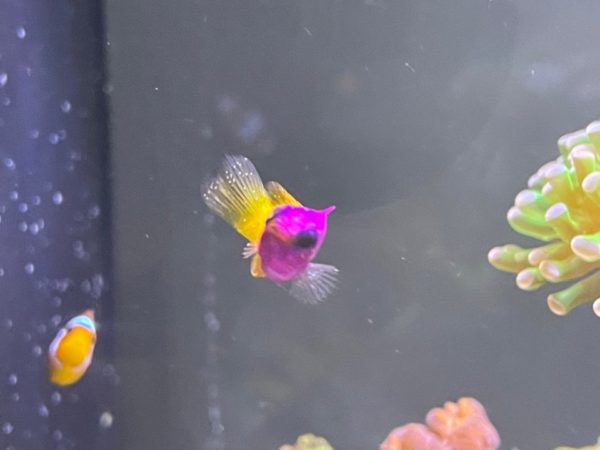
Other fish you can add to an aquarium filled with Royal Gramma would need to be peaceful as well, don’t explore too much and invade the Royal Gramma’s space, they shouldn’t be predatory, and they can’t look too much like the Royal Gramma either. They are not jealous because the fish coloring is as vivid as they are, but it will distract them.
Ideal Tank Mates
The ideal tank mates of the Royal Gramma species are Boxfish, Angelfish, Filefish, Clownfish, Jawfish, Gobies, Rabbitfish, Hawkfish.
Bad Tank Mates
As mentioned previously, they prefer peace, but they do not go along with their rival, the Royal Dottyback, so keep them separated.
Breeding
The Royal Gramma is easily one of the best fish to have as a beginner because not only do they have the ideal temperament, they are hardy, easy to care for, easy to feed, and easy to breed too! Breeding usually happens during the warmer months of the year. The males are the ones who build the nest, and the females will lay around a mere 5 to 40 eggs when they are ready. The male then fertilizes the eggs.
This is the routine for one breeding session, and there are multiple sessions that occur daily during the breeding month.
The eggs hatch within a week and usually during low light conditions (the evenings). Feed them small bits of food initially, and as they graduate to larger fryes, you can start their diet with brine shrimp. The trouble with raising baby Royal Grammas is that each batch hatches differently, with first-hatched grammas being more significant than the newly hatched ones.
It poses some difficulties for feeding, so make sure the food you feed can fit inside their mouths.
Royal Gramma Common Diseases
If you have Royal Gramma in your water tank, you need to be careful about their health, food, and other care involvements. And they get sick because of bacteria, fungus, and Marine Ich.
Difference Between The Royal Gramma And The Royal Dottybacks
To be honest, these rival species look similar at first. However, if you observe them, you will notice that unlike the purple and yellow combination in the body, the Royal Gramma has a black line through the eye starting from the mouth.
Moreover, the Royal Gramma possesses a black spot in the dorsal. And the Royal Dottybacks lack both these black lines and a black spot. Hence, they can be identified this way.
Facts About Royal Gramma
- They are pretty small but hardy. Though they are elegant, don’t be fooled as they are carnivorous. However, you don’t have to worry about your other fish, as fairy basslets are peaceful saltwater fish that make great tank mates.
- Sexing the fish in the early stages is nearly impossible, but as they grow older and gather in a shoal, the more dominant fish in the pack will change their sex to become male. Male royal gramma fish grow to be larger than their female counterparts.
- The Royal Gramma isn’t too fond of direct sunlight despite coming from the sunny Caribbean. This is due to the peaceful fish mainly living in deep water and not having much exposure to harsh light.
- Royal Grammas are peaceful fish that can play nice with other tank inhabitants. They are peaceful and can even be classified as timid. The Gramma Loreto is not known to be the one who starts problems in a tank. They sort of just keep to themselves in their favorite hiding places in the aquarium. That is not to say that they are pushovers. If they feel a fish is impeding their territory, they can and will chase them away even with their small size.
- As mentioned previously, Royal Gramma is the calming species by nature; however, If they feel threatened and need to attack, you will see them doing the gramma gape. This is when these tiny little fish open their mouths as wide as possible in an attempt to be intimidating.
- They only show aggression if they meet their rival Royal Dottybacks, who look similar.
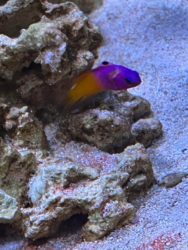
Is Royal Gramma Right For You?
Well, it is a common question asked by beginner fish enthusiasts. But, we hope after reading this article, you already know the answer. Undoubtedly, the Royal Gramma is the right choice for you if you can recreate their preferred place. It is beginner-friendly and requires only minimum care, a plus-point to many newbie aquarists.
FAQ’s
How Long Will A Royal Gramma Hide?
The Royal Gramma fish is shy and enjoys hiding under rocks, driftwood, caves, reefs, corals. Sometimes they keep them hidden for 4 to 5 days or a week. Therefore, if you have Royal Gramma in your water tank, you will likely see them hidden for a week or so.
Do Royal Grammas Jump?
The Royal Gramma is a species that prefers reefs of deep water, and they are fond of hiding in their favorite places. They can not swim well, so they only jump. So, ensuring a suitable lid for the water tank should be highly paid attention.
Is Royal Gramma Peaceful?
Yes, the Royal Gramma is peaceful and calming by nature, and they only react aggressively if anyone intrudes in their space. Additionally, they are not fond of the Royal Dottybacks.
Conclusion
The Royal Gramma is the best choice for any beginner or pro aquarist. Their variety of colors and soothing nature will attract you to watch them. Hence, if you plan to have an aquarium, a Royal Gramma can be the best call for you.
No related posts.
